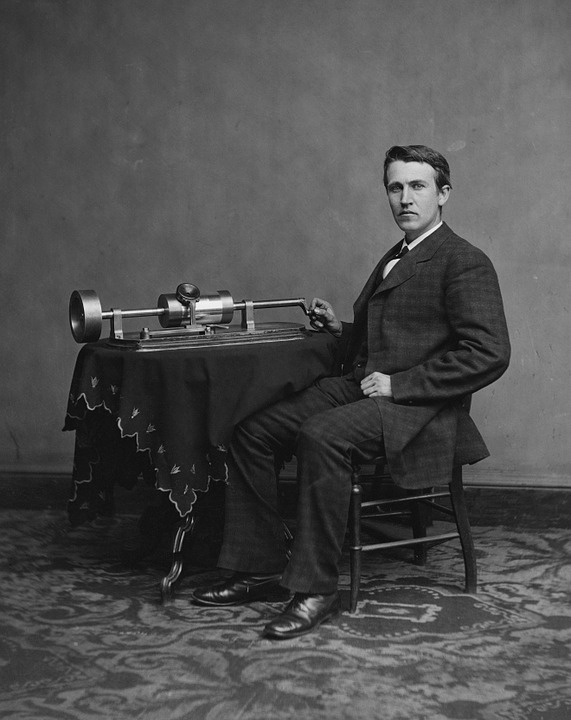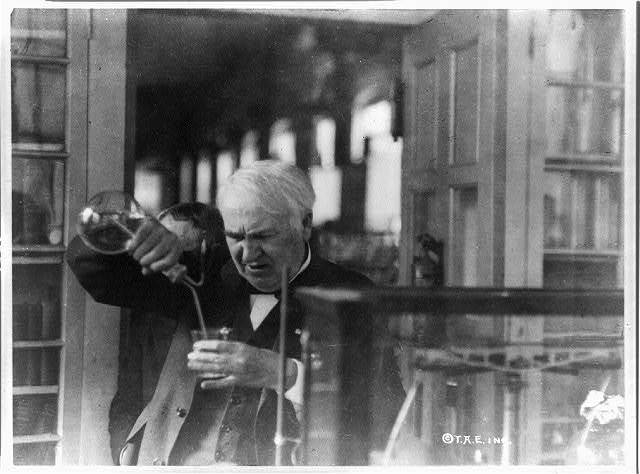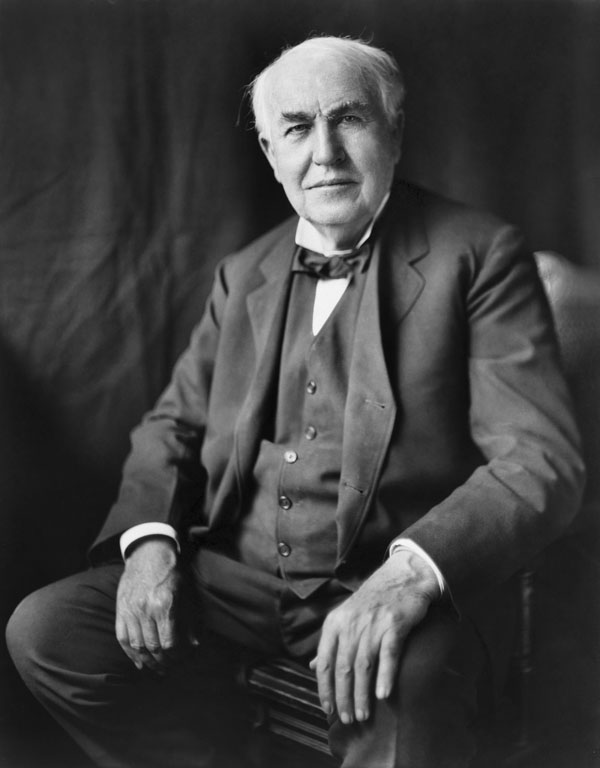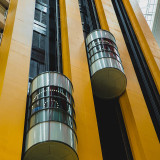Thomas Edison's Life and Legacy
Thomas Edison is one of the most industrious men to have ever lived in the United States. Widely regarded as the greatest American inventor of all time, his claim to fame as one of the fathers of electricity has cemented his place in history. There's a lot more to Edison than just having perfected the light bulb, however. Let's explore the life and legacy of Thomas Edison to learn more about this great mind.
Early Years
Thomas Edison was born on February 11, 1847 in Milan, Ohio. His parents were Samuel Ogden Edison Jr. and Nancy Matthews Elliott, the former a Canadian exile fleeing the law after participating in the Mackenzie Rebellion and the latter a teacher.1 Thomas was the seventh and last child of the two and the fourth to survive to adulthood.
The Edison family moved to Port Huron, Michigan seven years after Thomas was born. Following the move, Thomas began education at a local primary school, eventually dropping out after only a year due to being deemed a "difficult" child for his hyperactivity and attitude. While he attended classes on and off at various schools after that, much of Edison's education came from tutoring by his mother.
Significantly, these early years were when Edison's lifelong hearing problems would first manifest. Though the exact cause is uncertain (partially due to Edison's own embellishments), most attribute this to a combination of scarlet fever and frequent ear infections leaving the young boy with partial deafness in one ear and a complete lack of hearing in the other. Despite this, many remarked on Edison's love of music, surviving phonographs showing bite marks in the wood from where he would chomp into the machines to listen to the sounds through the vibrations.2
 Thomas Edison Portrait
Thomas Edison Portrait
Without a formal education to worry about, Edison spent much of his time selling various trinkets and papers on train cars going between Port Huron and Detroit. By all accounts, business was quite good, and Edison put most of what he earned into buying electrical equipment and various chemistry supplies to tinker with.3 He even sold his own newspaper by the name of the Grand Trunk Herald.
All this changed when Edison became a local hero. After being barred from selling on the trains when a conductor found out about his experiments, the young Edison was forced to sell exclusively at stations along the route. One fateful day in 1862, the 15 year old Edison would risk his life to save a small child from being hit by a runaway train, successfully rescuing him without major injury.4
This child, Jimmie MacKenzie, was actually the son of J. U. MacKenzie, a station agent who apprenticed Edison as a telegraph operator out of gratitude. Edison excelled at the job, using his position to experiment with telegraph technology and better understand electrical engineering. He also continued his chemical experiments in his free time.
Edison spent the next five years as an employee of the Western Union Telegraph Company, traveling from place to place as a telegraph operator mainly to fill in for those who had left their jobs to fight in the Civil War. In 1866, he moved more permanently to Louisville, Kentucky to work as an Associated Press' news wire. Working the night shift, he used the unsupervised time to experiment and read between moments of work - though this backfired in 1867 when experiment with sulfuric acid caused damage to his superior's desk, an offense that he was fired for.
Edison the Inventor
Returning home to Michigan, Edison found his family in dire condition. His father was out of work, his mother's mind was deteriorating due to untreated mental illness, and there were few left who would help them in their struggles. To try and find a way to benefit his family and advance in his own goals, Edison moved to Boston in 1868.
As a major cultural center for science and technology, Edison was inspired to begin serious work on his own advancements after setting up here. His first patent was granted in June of 1869 for a way to quickly count votes mechanically.5 Despite its usefulness, the Massachusetts legislature wanted nothing to do with the invention, and Edison left Boston for New York not long after.
 Thomas Edison circa 1882
Thomas Edison circa 1882
Edison met fellow inventor Franklin L. Pope after the move, the two becoming fast friends with Pope even allowing Edison to live and work out of the basement of his New Jersey home. It was around this time that Edison gave up his job as a telegraph operator in order to focus full time on his inventions. This worked out well for him as new advancements in equipment were slowly transforming telegraph operations into a more hearing-based job.
Pope and Edison soon went into business together. Over the next five years, the two supported each other and assisted one another in their inventions, Edison creating all manner of gadgets for their new enterprise. The first was the Universal Stock Printer, a device that synchronized various stock tickers to consolidate their transaction records to a single machine. This gave the two a substantial windfall, allowing them to set up a permanent laboratory in Newark and hire machinists to help with making their ideas a reality.
Edison the Entrepreneur
As an independent contractor, Edison should have been at a disadvantage given Western Union's control of much of the market. This was not the case, however, as Edison's extreme ingenuity put him on the cutting edge of all things telegraph and technological. So valued were his creations that Western Union and its competitors would frequently engage in bidding wars for who would gain access to his latest patents and ideas, with Edison deliberately encouraging this conflict for his own financial benefit.
This rivalry also helped Edison's creativity, the span of time between 1870 and 1875 being some of the most productive of his early career. His work in improving upon older technology or inventing new things outright led to the advent of things like the mimeograph, a precursor to the phonograph. He was also responsible for the quadruplex method for sending four telegraph signals across a single wire, greatly improving efficiency.
In 1871, Edison married his first wife, Mary Stilwell, with whom he had three children. Often called as irresponsible a shopper as Edison was a money manager, it wasn't long before the couple managed to squander their substantial fortune through overspending. To try and remedy this situation, Edison had his father moved out to live with them (his mother had died in the previous years) as he began construction on a new laboratory and home in Menlo Park. Using his hefty payments from selling the quadruplex designs, he and his family moved to the area in 1876 after the lab's completion.
 Edison posing with his famous phonograph invention.
Edison posing with his famous phonograph invention.
Along with his relatives, Edison also brought along Charles Batchelor and John Kruesi. Friends and collaborators of his, Batchelor was a renowned draftsman while Kruesi was a model maker. Between the three of them and the new environment, they revolutionized Edison's work output in ways they hadn't dared to dream before.
The Wizard of Menlo Park
One of the most significant discoveries Edison made during this time was the variable conductivity of carbon when under different pressures. Using this knowledge, they developed a type of pressure relay to improve the clarity of signals sent via the newly-created telephone. This led to the creation of the carbon button transmitter6 by the end of 1877, an invention so useful that it is still used in various speakers and microphones to this day.
This was also the year in which the phonograph truly came into being. As an extension of his work on telegraphs and the telephone, Edison theorized that pre-recorded sounds could be played back on a similar device using similar means. With some tinkering, he managed to imprint various sounds to sheets of paper that, when pressed by a carbon-tipped stylus, could reproduce the sounds that originally imprinted them.
The creation of the phonograph and its subsequent demonstrations were what truly brought Edison international acclaim. Dubbed the Wizard of Menlo Park, he was more popular than ever with both the public and various companies.
Despite being the invention that put him on the map, Edison more or less neglected the phonograph for a decade after this. His attention had fully shifted to electric lights. Though Humphry Davy may have been the first to create an electric arc lamp near the turn of the century, Edison was intent on improving the design substantially.
The Edison Electric Light Company was set up to accomplish this, formed at the end of 1878 with the help of various financial backers. Edison's ambitions were big, wanting both to create a working incandescent bulb as well as a lighting rig powerful and reliable enough to light an entire city. By the end of 1879, he'd done it, installing carbon filament lights in Menlo Park and giving demonstrations on how they worked to visitors.
 Edison in the lab demonstrating his lightbulbs.
Edison in the lab demonstrating his lightbulbs.
Edison's lights were such a success that he created a bulb manufacturing plant in East Newark by 1881, moving his family to New York later that year and installing the first lights to be powered by his Pearl Street Station power plant in Manhattan in 1882. Even more were installed after this show of success, the original 400 or so lights nearly tripling to over 10,000 in just a year.
War of the Currents
It was around this time that Edison found himself in conflict with other major players in the burgeoning electric power game. Chief among these competitors was George Westinghouse. Westinghouse's technology served as the antithesis of Edison's direct current (DC) power generation method, utilizing an alternating current (AC) system of power generation that could be made cheaper and supply power to areas that were more remote.
The battle between these two and the competing Thomson-Houston Electric Company (another major DC power company) lasted for much of the 1880's and into the early 1900's, each group attempting to pull ahead of the others through various cost cutting techniques and propaganda attacking the others. Famously, this included claims that DC power had never killed a single person, with Edison and others being quick to point out that AC-based wires had been involved in various fatal accidents.
The war was coming to a close by 1889 in large part because of the creation of an AC induction motor that ran with a DC dynamo, effectively making for the best of both worlds while still powering things with DC. This was somewhat ironic given Westinghouse's contributions to the AC side of things, especially with how much of the technology that would eventually lead to his "loss" was invented by Nikola Tesla, a former employee of Edison and a frequent collaborator with Westinghouse during these years.
In 1892, Edison's company merged with Thomson-Houston to form the General Electric Company,7 effectively removing Edison from what was left of the electric wars.
Later Years
In 1884, Edison's wife tragically passed away from a brain tumor. Though upset, he remarried not long after in 1886 to Mina Miller, the two moving to Glenmont Mansion in West Orange and eventually having three children of their own.
By 1887, Edison had created an even larger lab in his new home than the previous at Menlo Park. This was also the time he resumed work on improving the phonograph, largely due to the independent developments by inventors Chichester Bell and Charles Sumner Tainter and their graphophone that Edison did not approve of.
 Thomas Edison experimenting in his laboratory.
Thomas Edison experimenting in his laboratory.
In 1888, however, the North American Phonograph Company bought out Edison's phonograph company, assuming ownership and control of it as well as most others at the time. This changed once more after the company's founder fell ill, with Edison stepping in to oversee the business until its bankruptcy in 1894. As a result, Edison once again bought back ownership of the device and opened his own company two years later to fill the void.
The next few years saw Edison begin to step back from directly presiding over his works. While he was responsible for creating the kinetograph (one of the earliest motion picture cameras) in 1891, he tended to focus less on his inventions around this point. By 1911, all of Edison's business ventures consolidated under the banner of Thomas A. Edison, Inc., Edison himself largely delegating to others as the company's goals shifted from innovation to remaining relevant in the market.
In 1915, Edison was placed on the Naval Consulting Board during World War I, advising the military on various scientific factors that could help them during the fight. While Edison continued to research during this time (mostly within he realm of naval science), he was greatly unhappy as he felt that the military was not appreciative or receptive to his ideas.
 Thomas Edison in his later years.
Thomas Edison in his later years.
This was also the time in which Edison's health began to decline. Though he still consulted and worked with his business, complications with various illnesses and diabetes made it difficult for him to continue innovating as he once did. Two of his most notable features during these last few years were his search for an alternative to rubber and his friendship with Henry Ford.8
Edison would eventually die on October 18, 1931 in his Glenmont home, survived by his wife and children as well as his extensive legacy of genius.
References
- https://www.nps.gov/edis/learn/historyculture/samuel-and-nancy-elliott-edison.htm
- https://en.wikipedia.org/wiki/File:EdisonBiteMarks.jpg
- https://www.theatlantic.com/magazine/archive/2019/11/edmund-morris-edison/598357/
- https://www.biography.com/news/thomas-edison-train-accident-young-boy-saved-telegraph
- https://patents.google.com/patent/US90646
- https://en.wikipedia.org/wiki/Carbon_microphone
- https://en.wikipedia.org/wiki/General_Electric
- https://www.thehenryford.org/collections-and-research/digital-collections/expert-sets/101111
Recent Posts
-
Henry Ford: Automotive Visionary
Henry Ford was one of the pioneers of the automotive industry. Even today, 120 years after it was f
-
The Rise of the Elevator
For many people, elevators are one of those parts of everyday life that you just don't think about.




